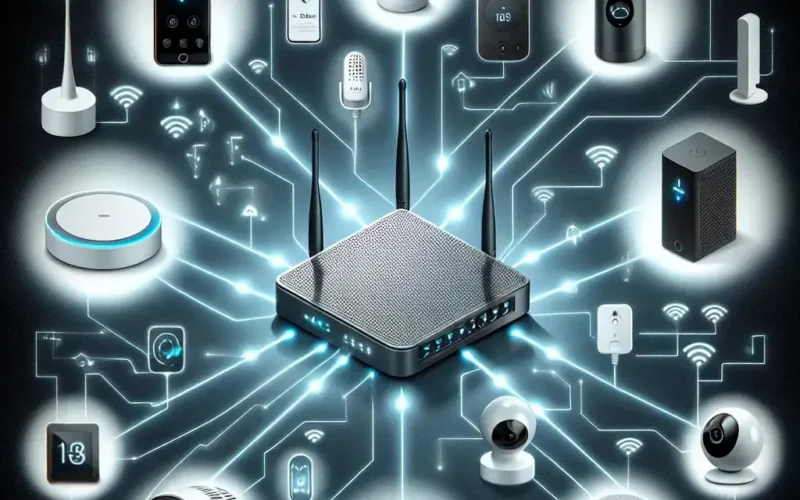Introduction
Setting up a router for home automation devices can seem daunting, but with the right guidance, it becomes straightforward. Home automation systems rely heavily on a robust and reliable Wi-Fi network to ensure seamless connectivity between devices. This article will walk you through the process step-by-step, from initial setup to optimizing and securing your network.
Step-by-Step Guide to Setting Up a Router for Home Automation Devices
1. Choosing the Right Router
Before we dive into the setup process, it’s crucial to choose a router that meets your needs. Consider the number of devices, the size of your home, and the specific features you require.
| Criteria | Considerations |
|---|---|
| Number of Devices | The router should support multiple connections simultaneously. |
| Wi-Fi Standard | Look for routers that support at least 802.11ac or the newer Wi-Fi 6 (802.11ax). |
| Coverage Area | Ensure the router can cover the entirety of your home. |
| Security Features | Opt for routers with robust security protocols like WPA3. |
2. Connecting Your Router
Once you’ve chosen an appropriate router, follow these steps to connect it:
- Unbox Your Router: Remove the router from its packaging and identify its antennas, Ethernet ports, and power adapter.
- Attach Antennas: If your router comes with detachable antennas, attach them according to the manufacturer’s instructions.
- Connect to Modem: Use an Ethernet cable to connect the WAN (or Internet) port of your router to your modem.
- Plug in the Router: Connect the power adapter to the router and plug it into an electrical outlet. Turn on the router.
3. Accessing the Router’s Admin Interface
To configure your router, you’ll need to access its admin interface:
- Connect to the Router: Use a computer or smartphone to connect to the router’s default Wi-Fi network (refer to the router’s manual for the default SSID and password).
- Open a Web Browser: Launch a web browser and enter the router’s default IP address (commonly 192.168.1.1 or 192.168.0.1) in the address bar.
- Log In: Enter the default username and password (usually found on the router or in the manual) to access the admin interface.
4. Configuring Wi-Fi Settings
Properly configuring the Wi-Fi settings is essential for a stable network:
- Change SSID and Password: Navigate to the wireless settings section and change the default SSID (network name) and password to something unique and secure.
- Select Wi-Fi Channel: Choose a less congested channel to minimize interference. Many modern routers have an automatic channel selection feature.
- Enable Dual-Band Wi-Fi: If your router supports 2.4GHz and 5GHz bands, enable both. Use the 2.4GHz band for devices that need a longer range and the 5GHz band for higher speeds.
- Set Security Protocol: Set the Wi-Fi security protocol to WPA3 if available or WPA2 for older devices.
5. Setting Up a Guest Network
For added security, setting up a guest network can be beneficial:
- Create Guest Network: In the router’s admin interface, enable the guest network feature and set up a separate SSID and password.
- Isolate from Main Network: Ensure that the guest network is isolated from the main network to prevent access to your primary devices.
6. Optimizing and Securing Your Network
To maintain a high-performance and secure network, follow these best practices:
- Firmware Updates: Regularly check for and install firmware updates for your router to improve performance and security.
- Network Monitoring: Monitor network traffic and connected devices through the admin interface to detect any unusual activity.
- Parental Controls: If applicable, set up parental controls to restrict access to inappropriate content.
- VPN Setup: Consider setting up a VPN on your router for added privacy and security, especially if you frequently access the internet for sensitive transactions.
7. Connecting Home Automation Devices
Now that your router is set up, you can start connecting your home automation devices:
- Device Compatibility: Ensure that your home automation devices are compatible with your network (most devices will work on a 2.4GHz band).
- Follow Manufacturer Instructions: Each home automation device will have specific instructions for connecting to the Wi-Fi network. Follow these carefully to ensure a successful connection.
- Group Devices: For better management, group your devices into categories (e.g., lighting, security, thermostats) within their respective apps or platforms.
Conclusion
Setting up a router for home automation devices involves several steps, from choosing the right router to configuring Wi-Fi settings and connecting devices. By following this comprehensive guide, you can create a robust, secure, and efficient home network that supports all your automation needs. Remember to keep your network secure and regularly update your router’s firmware to maintain optimal performance.






